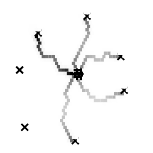Multi-agent approach to the self-organization of networks
Frank Schweitzer
Understanding and Managing Complex Agent-Based Dynamical Networks (2007)
Abstract
Is it possible to link a set of nodes without using preexisting positional information or any kind of long-range attraction of the nodes? Can the process of generating positional information, i.e. the detection of ``unknown'' nodes and the estabishment of chemical gradients, emphand the process of network formation, i.e. the establishment of links between nodes, occur in parallel, on a comparable time scale, as a process of co-evolution? The paper discusses a model where the generation of relevant information for establishing the links between nodes results from the interaction of many emphagents, i.e. subunits of the system that are capable of performing some activities. Their collective interaction is based on (indirect) communication, which also includes memory effects and the dissemination of information in the system. The relevant (``pragmatic'') information that leads to the establishment of the links then emerges from an evolutionary interplay of selection and reamplification.

